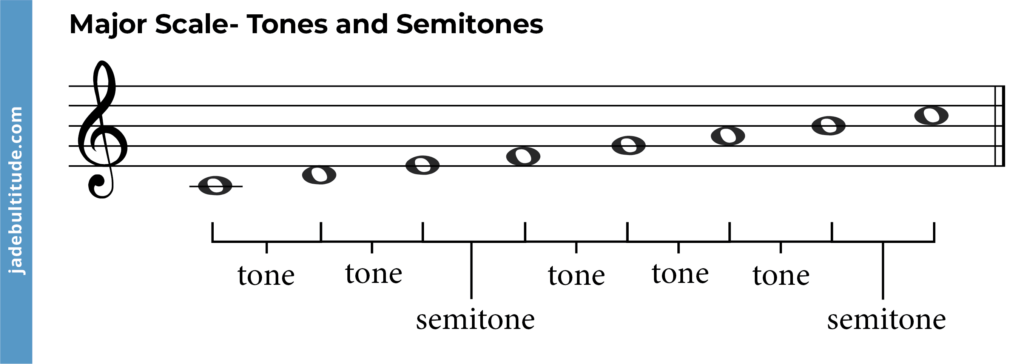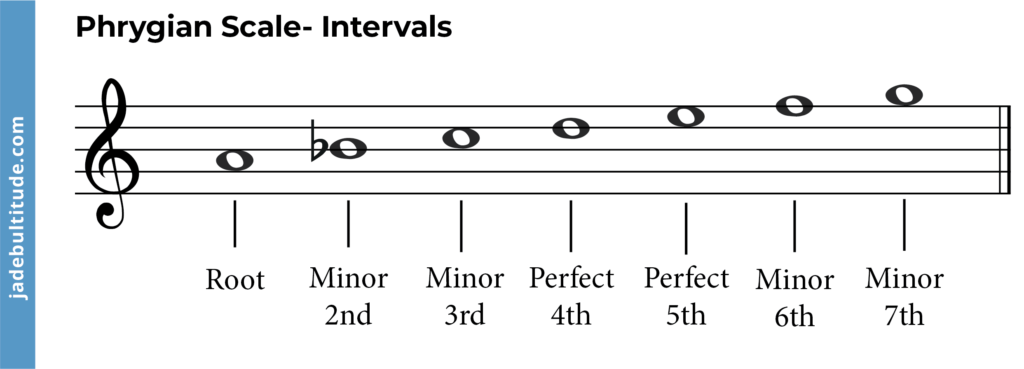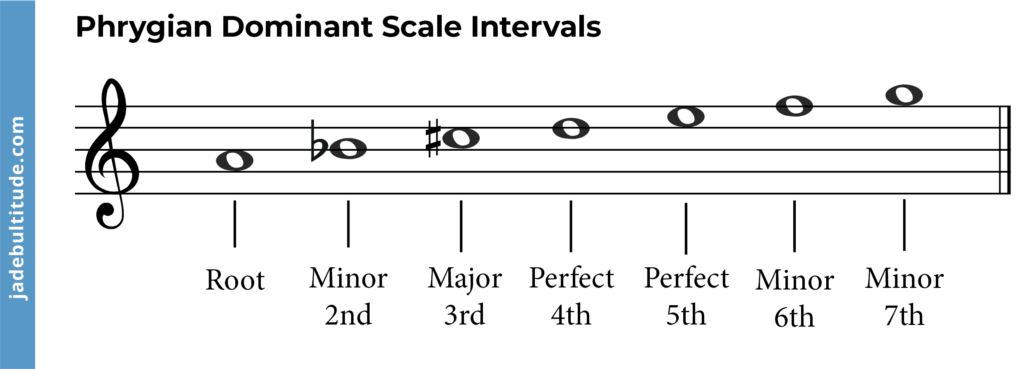There are many different scales in music and some are more common than others. You will have heard of major and minor scales but the diatonic modes are something totally different. Before we dive into the Phrygian mode, here’s a quick summary of what the modes are.
What are musical modes and why are they important?
The musical modes are a series of seven diatonic scales based on the major scale. The modes are sometimes referred to as Greek Modes or modal scales in music theory.
In any given major key you can play all seven modes. Each of these modes will start on a different scale degree. As you can see all the different modes are very closely related.
If we look at the note sequence of the modes in the C major scale they will be as follows:
C D E F G A B C – C Ionian Mode
D E F G A B C D – D Dorian Mode
E F G A B C D E – E Phrygian mode
F G A B C D E F – F lydian mode
G A B C D E F G – G Mixolydian modemajor
A B C D E F G A – A Aeolian Mode
B C D E F G A B – B Locrian Mode
All the notes above use the notes from the C major scale.
What is the Phrygian Mode?
The Phrygian mode is a mode that starts on the third scale degree of a major scale. As we saw above, if you are in C major, the phrygian scale will begin on E. E is the third degree of C major. It is the third mode of the seven modes. The playing the E Phrygian mode you will just use all the white notes on the keyboard. Take a look at it on the piano keyboard below, notice how only the white notes are highlighted.

Let’s look at some other keys/other scales to work out the Phrygian modes.
If you are in the F major scale, the Phrygian mode will begin on A. A is the third degree of F major. The mode you create will then be the A Phrygian scale.

If you are in the G major scale, the Phrygian mode will be begin on B. B is the third degree of G major. The mode you create will then be the B Phrygian scale.

From Major Scale to Phrygian Mode
As we have seen, phrygian scales can be created from the third degree of a major scale. Remember scale degrees just refer to the number note of the scale. The Phrygian scale is the third mode.
The pattern of whole step and half steps (semitones and Tones) in the major scale is as follows:
W W H W W W H (T T S T T T S)

As the Phrygian mode starts on the third degree of the major scale, this pattern will simply shift up.
The Phrygian Scale Formula
The pattern of whole steps and half steps (semitones and Tones) in the phrygian mode with therefore be as follows:
H W W W H W W (S T T T S T T )

Degrees of the Phrygian scale
The Phrygian mode is a minor mode. This simply means that this mode has many of the same qualities as a minor scale.
For a major scale to sound major, the third of the scale will be a major third. In the aeolian mode, this third degree is a minor third! This is what gives the scale it’s minor quality.
As well as having this minor third we also have a minor sixth, minor seventh and minor second intervals. The only other mode to have a minor second is the locrian mode!
The degrees in the phrygian mode will be as follows:
Root
Minor Second
Minor third
Perfect fourth
Perfect fifth
Minor sixth
Minor seventh

Comparing Phrygian to the Natural Minor Scale
The Phrygian mode is very similar to the natural minor scale. There is only one difference between the Phrygian mode and the natural minor and that is the flattened second scale degree.
The natural minor has a major second and the Phrygian mode has a minor second!

Music written in the Phrygian mode
Music written in the Phrygian mode has a very dark sound as it has so many flattened notes, you can hear it in classical music, film music, hip hop music, rock music and more.
Below are some examples in classical music.
Giovanni Pierluigi da Palestrina’s five motets of his cycle Canticum Canticorum (song of Solomon) are written in the E Phrygian mode.
Anton Bruckner’s ‘Symphony No. 6′ in A major, the maestoso movement also uses the Phrygian mode.
Howard Shore’s ‘One Ring to Rule’ them all is also a great example of the Phrygian mode, the F Phrygian scale to be specific.
We can also hear the Phrygian mode in popular music, take a listen to David Bowie’s ‘Space Oddity‘.
And also in ‘I Care’ by Beyonce!
Phrygian dominant scale
The actual Phrygian mode itself is not used as much as the Phrygian dominant scale. The Phrygian dominant scale is a more typical Phrygian mode and is also known as the Spanish gypsy scale which is used a lot in flamenco music.
The Phrygian dominant scale is almost the same as the Phrygian mode expect the minor third is actually a major third.
This means the Phrygian dominant scale will have the following scale degrees:
Root
Minor second
Major third
Perfect fourth
Perfect fifth
Minor sixth
Minor seventh

Take a listen to the Phrygian dominant in the famous flamenco music piece Malagueña
List of Phrygian modes
Although the E Phrygian scale is the easiest mode to create as it comes from the third note of the c major scale, meaning you only have to play the white keys on the piano, you can create a phrygian scale on any note you like! As long you keep the same interval pattern you can create the phrygian mode on any note. Each of the modes below have been created using the whole step and half step pattern we saw earlier.
A Phrygian mode – A Bb C D E F G A
Bb Phrygian mode – Bb Cb Db Eb F Gb Ab Bb
B Phrygian mode – B C D E F# G A B
C Phrygian mode – C Db Eb F G Ab Bb C
C# Phrygian mode – C# D E F# G# A B C#
Db Phrygian mode – Db Ebb Fb Gb Ab Bbb Cb Db
D Phrygian mode – D Eb F G A Bb C D
D# Phrygian mode – D# E F# G# A# B C# D#
Eb Phrygian mode – Eb Fb Gb Ab Bb Cb Db Eb
E Phrygian mode – E F G A B C D E
F Phrygian mode – F Gb Ab Bb C Db Eb F
F# Phrygian mode – F# G A B C# D E F#
Gb Phrygian mode – Gb Abb Bbb Cb Db Ebb Fb Gb
G Phrygian mode – G Ab Bb C D Eb F G
G# Phrygian mode – G# A B C# D# E F# G#
Ab Phrygian mode – Ab Bbb Cb Db Eb Fb Gb Ab
Chord progressions in the Phrygian scale
Phrygian scale chord progressions are a series of chords derived from the phrygian scale. To build a chord progression in the phrygian scale you must first simply choose chords that can be created with these notes. The first place to start is to create a chord (triad) on every note of the chosen phrygian mode. Below you can see a chord built on every note of the A Phrygian scale, notice all of the B notes are B flats.

Each of these chords can then be labelled so you know what each chord is. If you need to learn more chords, check out our complete guide to chords.

We can also use Roman Numeral notation to label the chords. Chord I in the A phrygian scale is a minor chord as the interval between A and C is a minor third. We will then label this chord with a lower case i to indicate that it is a minor chord built on the root of the scale. Each chord can then be labelled in this way and we will then know which chords have a minor quality and which ones have a major quality! If the chord has a major quality the third will be a major third and we will label this chord with capital Roman numerals.
Writing a chord progression just using chords from the Phrygian scale can sound somewhat awkward. You will most commonly see the Phrygian mode used to improvise with over the top of power chords (only the root note and fifth above). Doing this removes the major and minor keys quality of each chord.
Want to learn more?
For an overview of the modes see our complete guide for musical modes. Or see our individual guides below:
- Ionian mode
- Aeolian mode
- lydian mode
- Dorian mode
- mixolydian mode
- locrian mode
